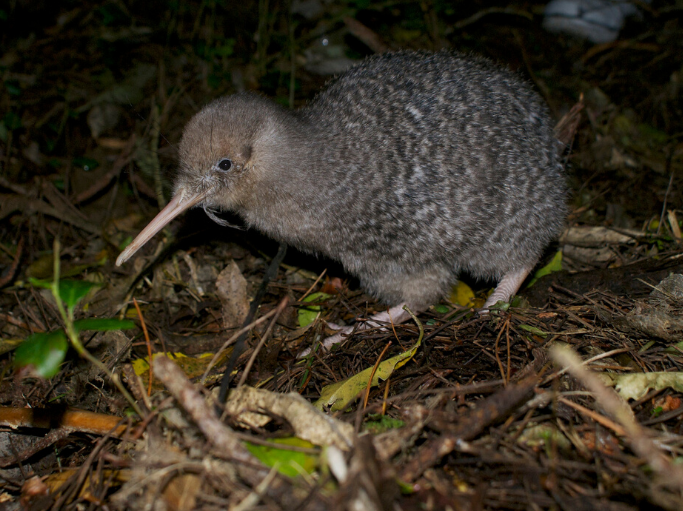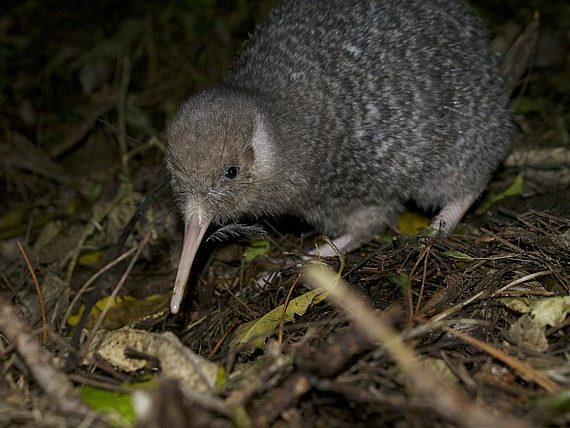The little spotted kiwi (Apteryx owenii) was probably the most common kiwi species in Aotearoa/New Zealand in the mid-1800s. Now it’s our second rarest kiwi of the 5 kiwi species. Numbers plummeted last century and it had almost disappeared from the mainland by the mid-1900s.
Then 5 birds were collected in 1912 and transferred to Kapiti Island. The island birds flourished, and it was the beginning of a series of translocations and island refuges for the species.

One of their more recent island sanctuaries has been Tiritiri Matangi Island, where Department of Conservation researchers Hugh Robertson, Natasha Coad, Rogan Colbourne and James Fraser recently surveyed population numbers as part of an ongoing monitoring project.
First some background on the Tiritiri Matangi population:

“Five birds that had been collected in South Westland in 1912 were established on Kapiti Island and the new population flourished to reach approximately 1200 birds by 2008, despite the small founder population and potential for inbreeding. In July 1993, five pairs of little spotted kiwi were transferred from Kapiti Island to Tiritiri Matangi Island; however, one of the males died shortly after being released due to transmitter entanglement and another male died in a flood in August 1994.”
It wasn’t the most auspicious of starts and meant that the founding population on Tiritiri Matangi was even smaller than intended.
“Since neither of these males bred while on the island, the initial founder population was a maximum of three males and five females. An additional two pairs and two males were introduced from Kapiti Island in July 1995, bringing the founding population up to a maximum of seven males and seven females.”
By 2013, the total population of little spotted kiwi was estimated at around 1700 birds, living on seven offshore islands (Taranga (Hen) Island, Tiritiri Matangi Island, Motuihe Island /TeMotu-a-Ihenga, Red Mercury Island (Whakau), Kapiti Island, Long Island and Chalky Island) and one predator-free mainland site (Zealandia, Wellington).
“Since 2013, a new island population has been established on Anchor Island and a second mainland site is being established at Cape Sanctuary, and the species is currently classified as ‘At Risk – Recovering’ under the New Zealand Threat Classification System,” the researchers report.
With the initial 1912 Kapiti Island population beginning with 5 birds, then only 14 descendants of those 5 birds later founding the 1990s Tiritiri Matangi population, a great deal of genetic diversity has been lost.
“Because the little spotted kiwi passed through a severe bottleneck (the five individuals introduced to Kapiti Island in 1912), it has the lowest genetic diversity of the five kiwi species and among the lowest recorded genetic diversity of all birds. Genetic diversity has also been lost in the process of establishing each of the new translocated populations. For example, samples taken from island-bred birds on Tiritiri Matangi Island up to 2012 showed a 12% loss of alleles per locus and a 4% loss of heterozygosity relative to the Kapiti Island population, which means that the kiwi here are likely to be less able to survive new challenges, such as exposure to a novel disease or environmental change.”
The genetic diversity of Tiritiri Matangi kiwi could still be improved, however.
“The founding population on Tiritiri Matangi was a maximum of 14 breeding birds, which is well below the usual recommended 40 unrelated founders for kiwi populations. Therefore, the addition of new birds to the island would help to increase the genetic diversity of the population as long as they are assimilated into the breeding population.”
So how many birds are there currently on Tiritiri Matangi?
“We assessed the population size of little spotted kiwi on Tiritiri Matangi Island between 17 and 30 April 2017, as part of the long-term 5-yearly monitoring programme that was established under the Kiwi Recovery Programme. We were assisted at various stages by the two local DOC rangers, a rotating team of 13 volunteers from the Supporters of Tiritiri Matangi Inc., four members of the Shakespear Open Sanctuary Society Inc. and one DOC volunteer.”
Certified kiwi dogs played an important role too.
“[At night] we used a certified kiwi dog, Jade, to indicate the presence of kiwi near tracks or any birds that were cautiously approaching the recorded calls, which we also attempted to catch by hand. During the day, we tracked the radio-tagged birds to their daytime dens to plot their home ranges more accurately and to determine whether they were with a partner. We also used certified kiwi dogs (Breeze, Cara, Duke, Jade and Peg) during the day to search for new birds or to pin-point the location of radio-tagged birds.”
“We caught 31 little spotted kiwi (28 adults, 2 subadults and 1 juvenile) on Tiritiri Matangi Island between 17 and 30 April 2017, including 3 of the 14 founders introduced from Kapiti Island in the mid-1990s and 9 island-bred birds that had been banded during 5-yearly monitoring visits between 1997 and 2012. Based on the locations of captures, radio-tagged birds, sightings and the projected origins of calls heard, we estimated that there were at least 25 pairs and a total population of 60–80 kiwi on Tiritiri Matangi Island.”
It’s a good increase on 14 founding birds, but 60-80 kiwi wasn’t as many birds as the monitoring team hoped to find.
“This represents a decline from the 2012 estimate of 80–100 birds, possibly due to the severe drought that was experienced in early 2013. However, the birds were generally in good to excellent condition and were heavier than their conspecifics on Kapiti Island at that time of year.”
Flightless birds living on islands or in fenced sanctuaries are particularly vulnerable to environmental and climate events such as droughts. They can’t leave in search of water or better living conditions.
“Although an undetected disease outbreak may have been the cause of the decline or plateauing of the population, it seems more likely that many birds died during the severe drought that affected the island in early 2013. Unusually, two unbanded island-bred birds were discovered active in daylight, and both subsequently died at Auckland Zoo of complications from severe dehydration. These two birds may have just been the tip of the iceberg and many others likely died without being found.”
MetService records reveal just how severe the drought was in the area in 2013.
“A MetService automated weather station located 5 km from the island on the tip of Whangaparaoa Peninsula recorded a total of 10.6 mm of rainfall in the first 2 months of 2013, which was less than 10% of the 30-year (1981–2010) average of 124 mm. This drought in early 2013 followed on from a drier than normal last quarter in 2012 when 159 mm, or < 70% of the long-term mean of 242 mm, of rain fell.”
“Although kiwi can obtain all of their water requirements from the invertebrates they eat, this drought may have taken its toll on the population if litter and soil invertebrates became scarce and/or retreated deep into the soil where they were out of reach of kiwi.”
Because of concerns about inbreeding and a resultant lack of genetic diversity, the 2017 survey was also an opportunity to locate and capture little spotted kiwi for a sanctuary swap.
“At the end of our survey, 10 adult females were transferred to Shakespear Open Sanctuary at the tip of the adjacent Whangaparaoa Peninsula and 10 new adult females were introduced from Kapiti Island in an attempt to increase the genetic diversity of the Tiritiri Matangi Island population. However, the maximum of 24 founders is still below the 40 founders that is usually recommended. Therefore, we recommend that at least 10 additional kiwi are transferred to Tiritiri Matangi Island to improve the genetic resilience of the population to challenges such as diseases or environmental perturbations, and that 5-yearly monitoring and annual call counts are continued.”
Further droughts, triggered by global climate change, remain a threat to the island population and may reduce the number of kiwi the island is able to support in the longer term.
“The Kiwi Recovery Plan 2018–2028 includes a goal to increase the population of little spotted kiwi by an average of at least 2% per annum, making the continued monitoring of the Tiritiri Matangi Island population essential. From the perspective of all kiwi taxa, it will also be of interest to assess whether the capacity of the island is lower than predicted as a result of severe droughts, especially if such extreme weather events become more frequent with global climate change.”
The full report has just been released by the Department of Conservation and is freely available through the DOC website:
Status of little spotted kiwi (Apteryx owenii) on Tiritiri Matangi Island in April 2017 (2019)

